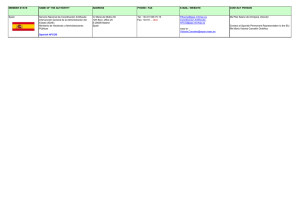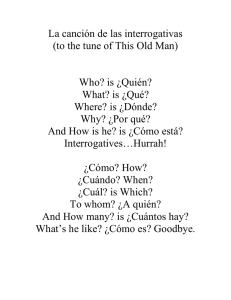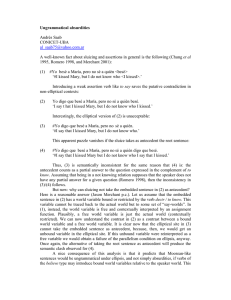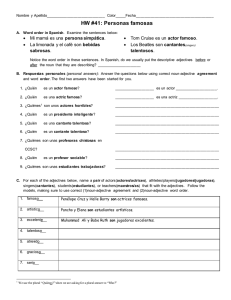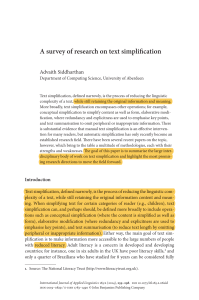What subextraction from depictives can tell us about lexical aspect in
Anuncio
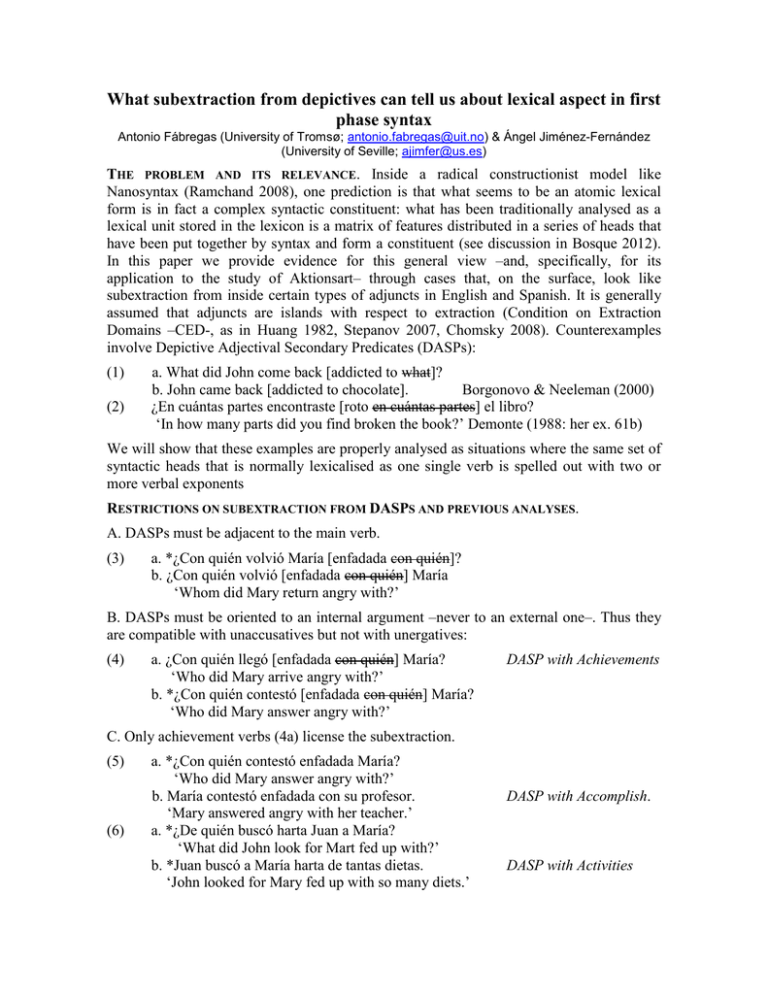
What subextraction from depictives can tell us about lexical aspect in first phase syntax Antonio Fábregas (University of Tromsø; [email protected]) & Ángel Jiménez-Fernández (University of Seville; [email protected]) THE PROBLEM AND ITS RELEVANCE. Inside a radical constructionist model like Nanosyntax (Ramchand 2008), one prediction is that what seems to be an atomic lexical form is in fact a complex syntactic constituent: what has been traditionally analysed as a lexical unit stored in the lexicon is a matrix of features distributed in a series of heads that have been put together by syntax and form a constituent (see discussion in Bosque 2012). In this paper we provide evidence for this general view –and, specifically, for its application to the study of Aktionsart– through cases that, on the surface, look like subextraction from inside certain types of adjuncts in English and Spanish. It is generally assumed that adjuncts are islands with respect to extraction (Condition on Extraction Domains –CED-, as in Huang 1982, Stepanov 2007, Chomsky 2008). Counterexamples involve Depictive Adjectival Secondary Predicates (DASPs): (1) (2) a. What did John come back [addicted to what]? b. John came back [addicted to chocolate]. Borgonovo & Neeleman (2000) ¿En cuántas partes encontraste [roto en cuántas partes] el libro? ‘In how many parts did you find broken the book?’ Demonte (1988: her ex. 61b) We will show that these examples are properly analysed as situations where the same set of syntactic heads that is normally lexicalised as one single verb is spelled out with two or more verbal exponents RESTRICTIONS ON SUBEXTRACTION FROM DASPS AND PREVIOUS ANALYSES. A. DASPs must be adjacent to the main verb. (3) a. *¿Con quién volvió María [enfadada con quién]? b. ¿Con quién volvió [enfadada con quién] María ‘Whom did Mary return angry with?’ B. DASPs must be oriented to an internal argument –never to an external one–. Thus they are compatible with unaccusatives but not with unergatives: (4) a. ¿Con quién llegó [enfadada con quién] María? ‘Who did Mary arrive angry with?’ b. *¿Con quién contestó [enfadada con quién] María? ‘Who did Mary answer angry with?’ DASP with Achievements C. Only achievement verbs (4a) license the subextraction. (5) (6) a. *¿Con quién contestó enfadada María? ‘Who did Mary answer angry with?’ b. María contestó enfadada con su profesor. ‘Mary answered angry with her teacher.’ a. *¿De quién buscó harta Juan a María? ‘What did John look for Mart fed up with?’ b. *Juan buscó a María harta de tantas dietas. ‘John looked for Mary fed up with so many diets.’ DASP with Accomplish. DASP with Activities (7) a. *¿De quién esperaba harta María? ‘Who was Mary waiting fed up with?’ b. María esperaba harta de su hermano. DASP with States ‘Mary was waiting fed up with his brother.’ The grammaticality judgements have been obtained through an experiment with 161 informants. (SYNTACTIC) ANALYSIS. We adopt Ramchand’s (2008) constructionist approach, where the maximal size of an event in the syntax is [InitP [ProcP [PathP [ResP]]]]. Assuming that every lexical verb consists of a subset of these heads, we argue that apparent adjuncts allowing subextraction project as Paths inside the event structure, as in (8). The path structure is lexicalised by the DASP and the main predicate lexicalises the other projections, but both items (V and DASP) integrate in the same syntactic space. In fact, we suggest that a ‘complex predicate’ is nothing but the situation that emerges when more than one lexical exponent spells out the syntactic space where Aktionsart and argument structure are defined. (8) [InitP <llegar> [ProcP <llegar> [PathP <enfadada>[ResP <ø>]]]] In set-format (9), at the point where the PathP is projected, we typically have a merge operation involving two complex sets (9a, 9b). The Path set projects its label to the resulting set (9c). Note that (as seen in 9c) the DASP is not an adjunct; adjuncts never change the label of the set they merge with. (9) a. {Path, {{Path}, {Proc,{{Proc}, {wh}}}}} (DASP) b. {Res, {{Res}, {P}}} (part of the main predicate built at that point) c. {Path, {{Path, {{Path}, {Proc,{{Proc}, {wh}}}}}, {Res, {{Res}, {P}}}}} Subextraction from DASPs is possible only if the main verb is an achievement. This is accounted for in our proposal as follows: in order to integrate with DASPs in the same syntactic space, the main verb must not spell out PathP, because DASPs are merged as projections of Path. Achievements –arrive–, being instantaneous changes of state, leave PathP unprojected. However, accomplishments –eat– and activities –run– project PathP, because they contain a measure of change across time, and as such they do not leave space for BPPs and ASPs to integrate with them. States –know–, not containing ProcP, cannot license Path syntactically, so DASPs are impossible in general with them. Consider now the restriction on the internal argument. In order to modify an external argument –which is merged in InitP, the highest projection in the verbal domain–, minimality should be violated: (10) shows that given usual assumptions about minimality, Init and Proc can have the same argument, Proc and Path too, but not Init and Path. (10) a. [X Init b. [X Init c.*[Y Init [X [Y [X Proc Proc Proc [Y [Y [Y Path ...]]] Path ...]]] Path...]]] The preference for adjacency between the main predicate and the DASP trivially follows if they share the same restricted syntactic space. Selected references. Bosque, I. 2012. On the Lexical Integrity Hypothesis and its (In)accurate Predictions, IBERIA:IJLT 4, 140-173. Demonte, V. 1988. Remarks on secondary predicates: c-command, extraction and reanalysis, The Linguistic Review 6: 1-39. Ramchand, G. 2008. Verb Meaning and the Lexicon: A First Phase Syntax. CUP. Stepanov, A. 2007. The end of CED? Minimalism and extraction domains, Syntax 10, 80-126.
